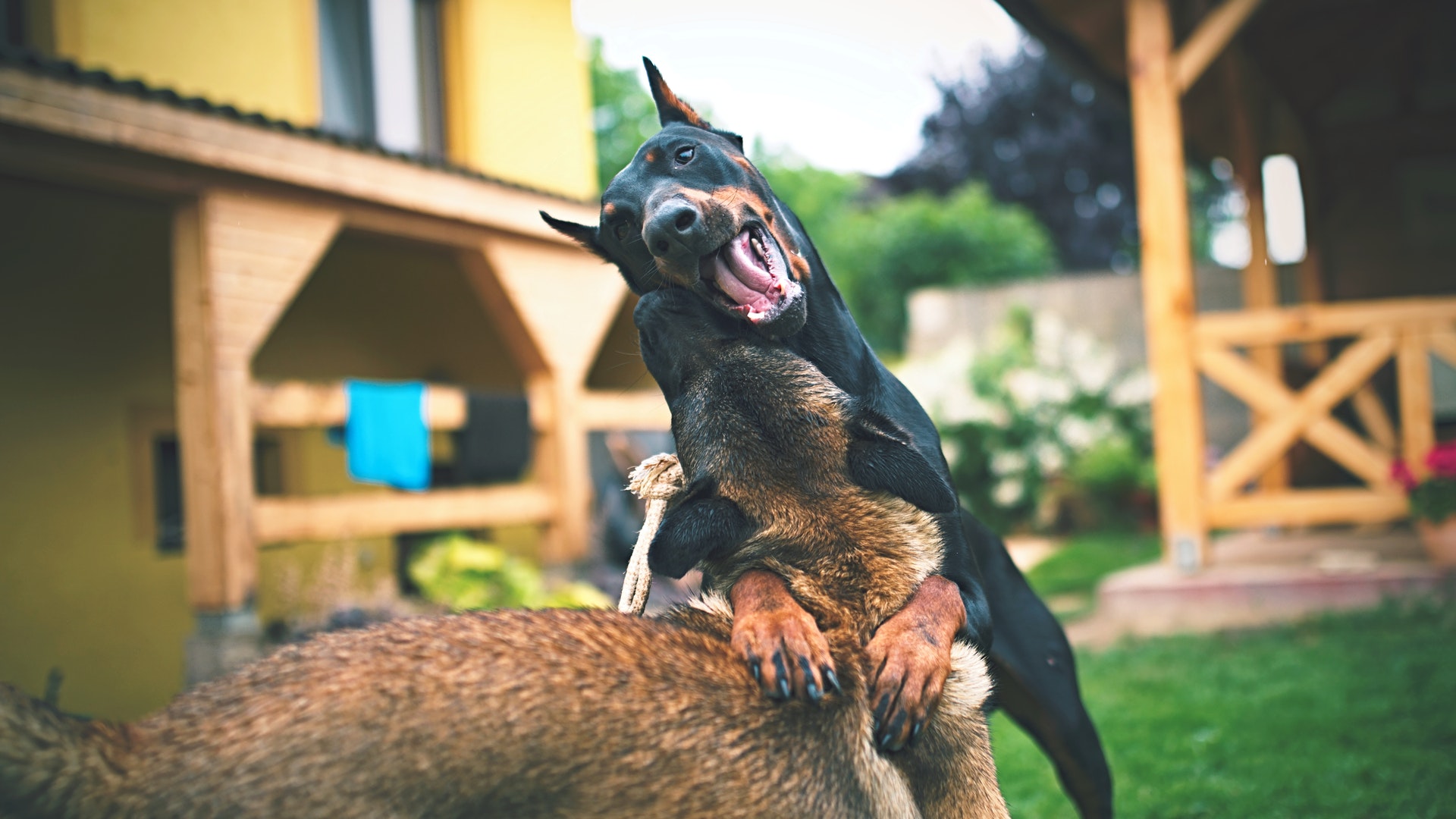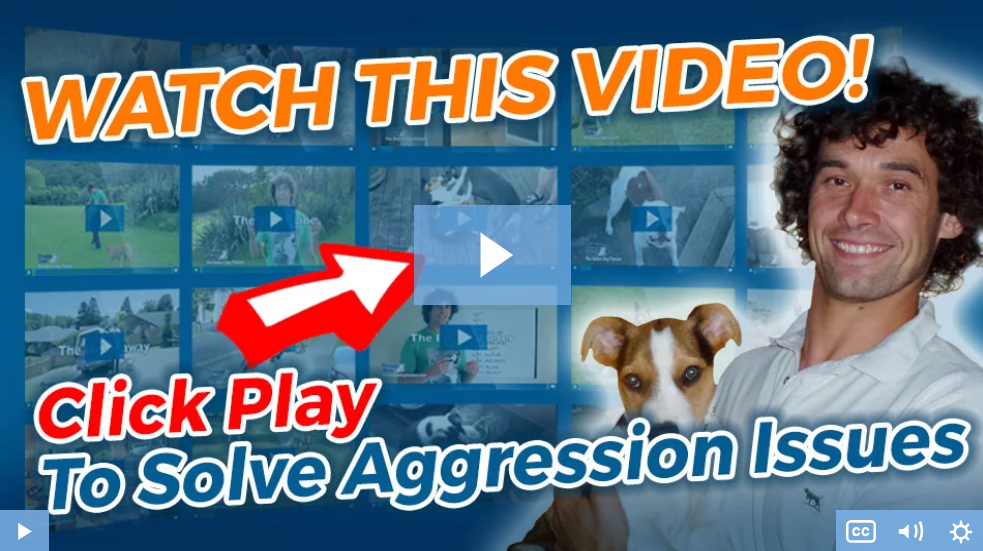While all dogs are inherently social creatures, learning how to socialize an aggressive dog can sometimes be a challenge.
Some breeds, including those originally kept for defensive purposes, are much more likely than others to retain a sense of natural aggression, whereas others are generally much more passive.
However, any dog can develop aggressive tendencies if there are flaws in their socialization.
And while difficult, it is not impossible to socialize dogs that develop aggression in their later years.
You see, encouraging sociability is not just something you should focus on with younger dogs or puppies.
Adult dogs also need to be encouraged throughout their lifespan.
So in this post, we’re going to be covering every single element of calming your dog’s aggressive behavior while showing you the essential socialization techniques to owning a happy well-adjusted canine.
So let’s get to it…
(video will open in a new window)
What Causes Aggression In Dogs?
Understanding the reasons for your dog’s aggressive personality is the foundation of working towards an effective solution.
There is no such thing as a ‘bad dog’ and if anything, the way your dog exhibits his behavior is much more matter of fact than humans!
That being said, there’s still a variety of reasons why dogs can become volatile.
Now I know I’ve already mentioned breeds but I feel it’s wrong and quite frankly lazy to stereotype certain types of dog as being naturally more aggressive than others
For example, Alsatians are the preferred dog for most police forces and militaries across the world.
But put them in a loving environment and they are also capable of being affectionate and relaxed family pets.
On the other hand, a Collie may be an endless ball of fun and energy, but that doesn’t mean they can’t become overexcited and develop a tendency to snap or snarl.
So if we can’t diagnose aggression by breed, we need to pinpoint other factors that cause some dogs to be more aggressive than others.
Now, just to give you an example of what social aggression looks like and how to deal with it, take a quick look at the video below…
Aggressive Factors
There are two other factors that most dog trainers will agree as being much more significant than breed.
Genetics do have an influence, and dogs with parents who are trained to be aggressive will more likely follow suit.
But did you know that it is a veterinary fact that mothers who experience regular and extreme stress while pregnant undergo hormonal changes that are passed to their offspring?
This can make their puppies intrinsically aggressive despite many other positive influences.
And while nature may play a role in some circumstances, the primary reason dogs become aggressive depends more on their experiences.
Does Age Make A Difference?
Never assume that aggression is developed in the early years.
It’s actually much more likely that dogs who experience periods of extreme stress at any stage of their life can suddenly change their character for the worse.
And while abuse and maltreatment is a certain way to cause this, it can also be due to a simple lack of care or socialization.
Antisocial Behavior
Dogs that may not be physically harmed, but instead just ignored, are at great risk of becoming antisocial.
From their perspective, they may have simply given up on groveling or whining for attention.
So instead, what they do is focus on behaving badly because they know it’s the only way that they’ll get attention.
The more they ‘play up’, the more attention they receive, even if it is a verbal scolding or even physical punishment.
Other reasons for antisocial behavior can include:
- Being a sickly pup and isolated from the mother and rest of the litter.
- Coming from a pet store where early socialization is typically next to non-existent.
- Rescue dogs are also often provided with little interaction with keepers or other dogs. This is a particular problem with dogs that have been difficult to rehome.
- Lack of knowledge on the part of their owner can inadvertently cause poor socialization.
How NOT To Socialize An Aggressive Dog
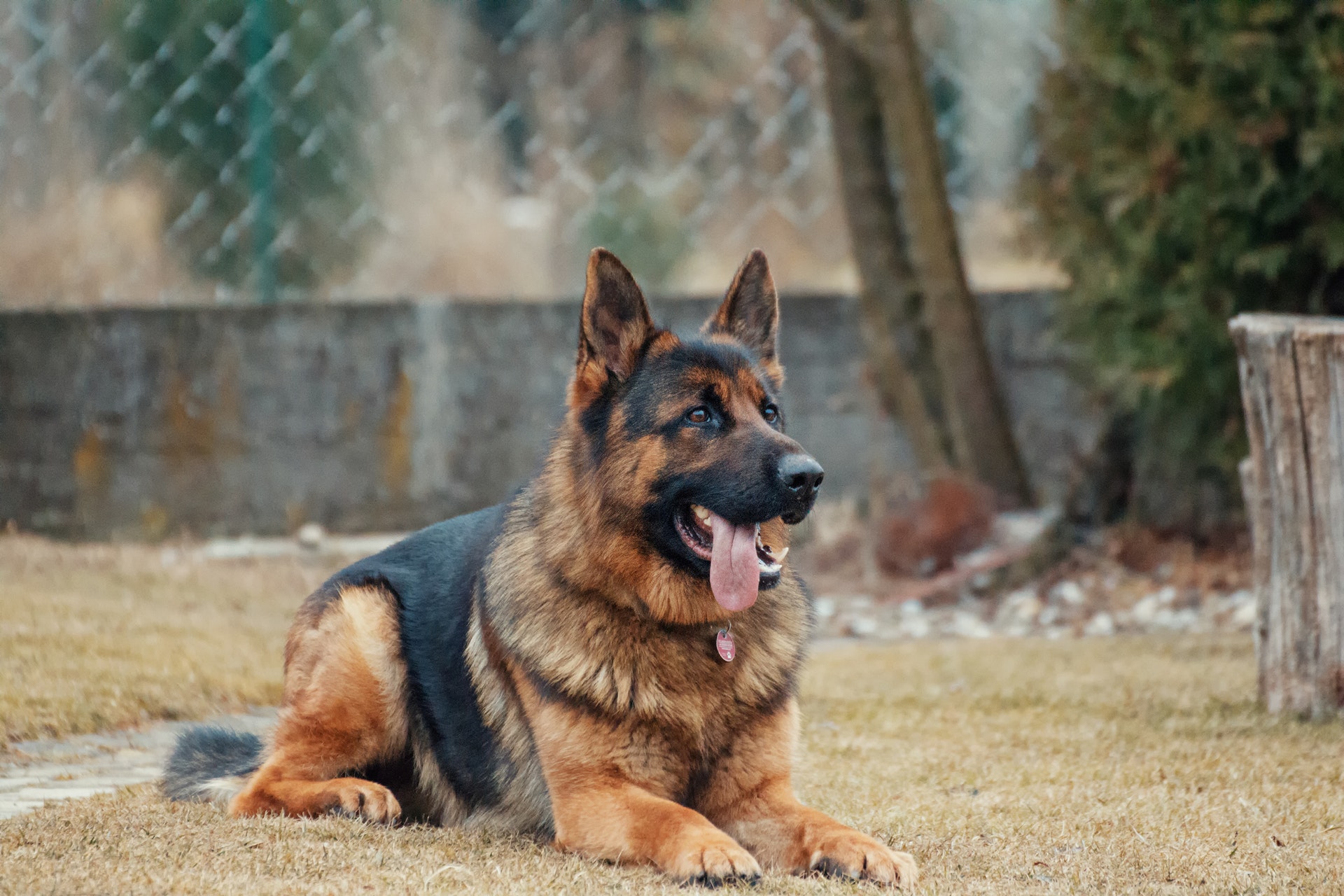 Many dog behavior experts agree that many ‘traditional’ ways of trying to control a wayward dog are now absolutely counterproductive.
Many dog behavior experts agree that many ‘traditional’ ways of trying to control a wayward dog are now absolutely counterproductive.
The problem is that from an owners perspective, they are often the simplest and provide what amounts to a selfish way of making themselves feel better for their dog’s poor behavior.
For example, yanking the leash when a dog exhibits aggressive behavior will rarely have any lasting benefit.
In fact, it can make it even more prone to barking/snarling because it associates proximity to other dogs as leading automatically to punishment.
The natural reaction is to try and scare away the other dog and the only way to do that is to exhibit aggressive behavior that will be reinforced every time the leash is tightened.
Some dogs have to endure this mindset their entire lives due to the owner not being aware of this simple fact.
Shouting Doesn’t Help
Shouting at your dog will naturally invoke a stress reaction.
This can result in two very contrary reactions.
Firstly, some dogs will become so stressed out by this that they will bark even more at both yourself and other dogs/people.
Others may learn that displaying their unease leads to a verbal scolding, so will instead adopt appear calm even when their stress levels are at an all-time high.
In the worst-case scenario, your dog can become prone to suddenly attacking other dogs seemingly out of the blue.
Need To Socialize Your Aggressive Dog? Click Here To Discover How To Finally Solve Your Dogs Aggression Problem And Get Them Fully Socialized By Using Simple, Highly Effective Calming Exercises That Takes Just Minutes A Day To Implement!
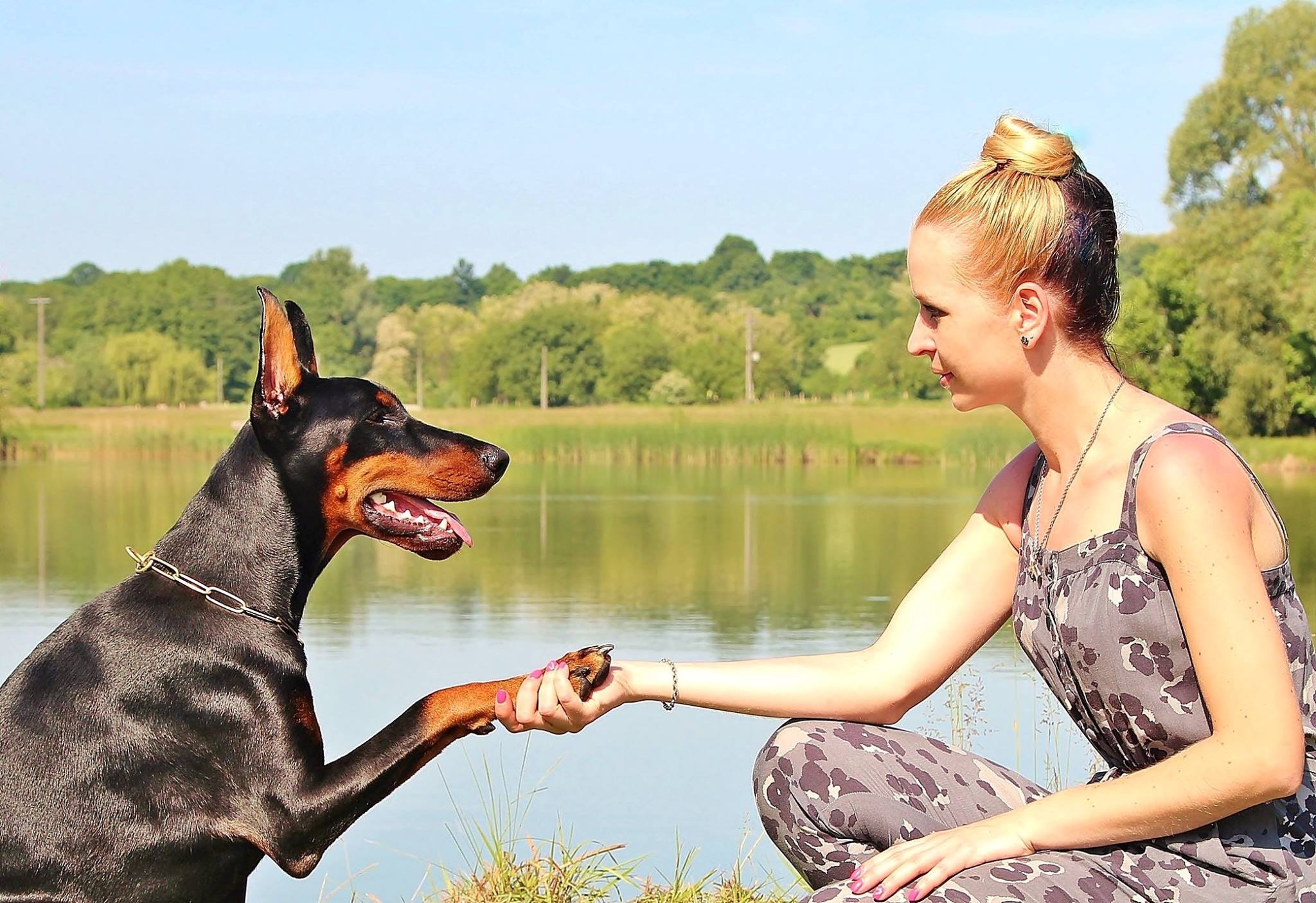
How To Socialize An Aggressive Dog The Right Way
So now we have outlined the basics of what makes some dogs aggressive, it’s time to look towards how to successfully develop a plan of action to counter this behavior.
Quite clearly adopting an aggressive or approach does not work.
And this is something which the vast majority of expert dog trainers will agree with.
So for this section, we’re going to explore how dogs of all ages – including those from typically ‘aggressive’ breeds can be effectively encouraged to control their aggressive tendencies.
And I guarantee that if you practice these routinely, you’ll find that in time, your dog will become more placid and confident around others.
Encouragement And Reward Training
Now I’d like you to take a moment to consider the following from your dog’s perspective.
While out for a walk you spot another dog at a distance and immediately feel stressed out and threatened.
As you become closer these feeling become so intense that you are compelled to growl and then bark at the other dog.
Your owner lets out a shout you do not understand, but it is clear they are angry by their tight yanking on your leash.
This makes you panic more, so much so that you feel no other option than to fight the other dog, who may or may not be exhibiting the same feelings.
You are then dragged away and then home by your angry owner.
Once indoors and off the leash, you are given some treats to calm you down and despite the stress, the treats taste good so it was totally worth it.
You then think to yourself “We’ll do that again tomorrow”.
It’s clear to see from the example above that one wrong move can set your dog up for a lifetime of bad behavior.
And controlling treats and rewards is perhaps the most popular initial method of helping to socialize a dog that exhibits this level of stress reaction.
But only when used correctly.
Never underestimate the speed at which dogs will become aware that their various privileges are associated with certain types of behavior.
And even the most difficult dogs can learn that their owner controls all the treats and that pleasing them is essential in order to keep the treats coming.
4 Stages Of Treat Training
There are four stages to this which need to be planned out in advance and religiously stuck to.
Treats are only ever awarded when the dog exhibits good behavior:
Stage 1
Allow a month for the dog to learn that treats are now a reward and not a privilege.
They are never to be given for the sake of it – only when it is demonstrating consistently good behavior. Some trainers refer to this stage as shaping.
Stage 2
The next stage is to try and desensitize the stress that the dog experiences when close to others.
Usually, this is done by standing a good distance away from another (on the leash of course) and rewarding with treats for every yard or so that they get closer without demonstrating aggressive tendencies.
Depending on your dog, this can take days or months of practice.
But the objective is for them to become not just used to the other dog, but to associate this as a form of good behavior that you will reward.
Stage 3
When you are at the stage where you can essentially walk up very close to another dog using only a couple of treats, it is time to attempt counter conditioning.
Essentially this means pairing up in the company with a by now familiar other dog & owner and going for a walk.
Keep a distance to begin with and take it easy, but make this a regular routine (ideally daily).
Award treats only when your dogs are very close to each other, taking particular care the first few times you try it.
Stage 4
Continue training your dog to obey other commands.
Seeing as many aggressive dogs tend to also be generally disobedient, further training will help to reinforce that good behavior equals rewards.
These may be verbal cues such as ‘sit’ or more advanced instructions.
But even dogs who learn the principles quickly will still likely be prone to the occasional outburst.
So using non-physical behavior such as turning your back or stopping still during a walk.
Trust me, it will get the message over in time.
And remember, never lose your cool and resort to yanking the leash or shouting.
Related Post: My Dog Keeps Attacking My Other Dog For No Reason
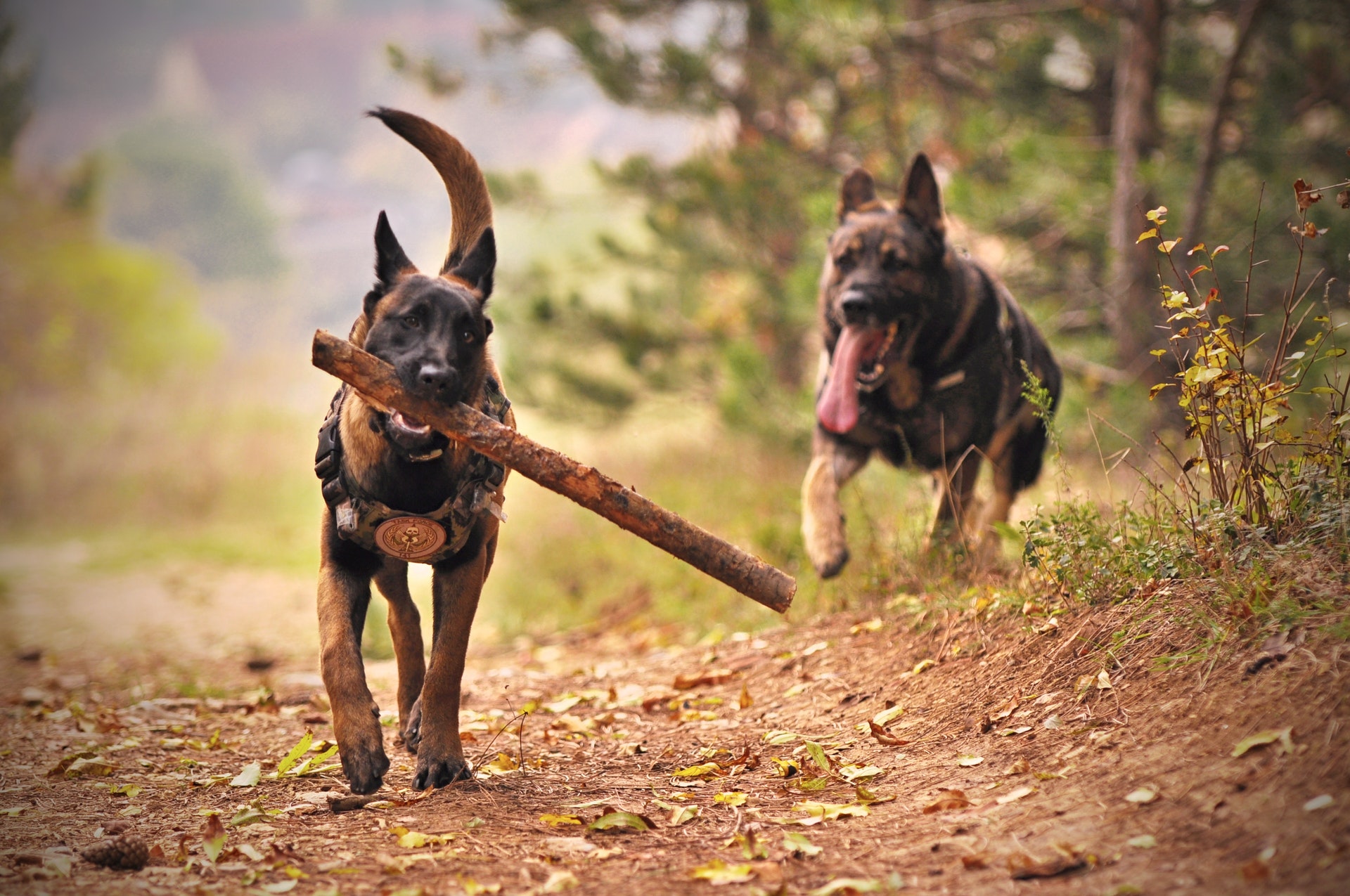
Take The Lead When Introducing Dogs
Ultimately the key is for you to feel comfortable that your dog is going to be relaxed around others.
Many owners become extremely frustrated that no matter how much they try, the mere sight of a distant dog is going to send their pet into a barking fit.
So a tried and tested technique is for you to take the lead.
Owners come up with all kinds of names for this so for this example we’ll opt for ‘cheery times!’.
The moment another dog is sighted, make sure you become especially chirpy and playful with your dog.
Offer treats, adopt a cheery voice and scrub/pat their favorite spots.
When the dog sees that you’re totally chilled out and happy about the other dog’s presence. He will in time, adopt a similar attitude.
You see, all dogs are essentially wired to be pack animals and will follow the lead of their Alpha (you).
If you are silent and nonengaging then there’s a good chance your dog will view this as you exhibiting caution or stress.
This can cause your dog to react in a negative way by either barking or straining.
But act positively and good things will follow.
The Passer-By
One variety of this technique is ‘the passer-by’.
It involves tying your dog securely to a post (this may not be suitable if the dog is not used to it) and standing beside it.
A training partner and their dog should be waiting out of sight around a corner.
About 30 yards or so ought to be fine.
After a couple of minutes time them to emerge slowly and immediately start ‘cheery times!’ with your dog and giving them treats.
The other pair should keep their distance and just pass out of sight. Over time, gradually bring them closer together until eventually, the other dog will be able to pass right by without raising a reaction.
It can take months to reach this stage but proximity training is an essential component to calming any dogs aggressive tendencies.
Classes For Aggressive Dogs
No owner should like having to take their dog to aggression training, yet there is a good deal of evidence that specialist training groups can work wonders for aggressive dogs.
The idea behind this is to provide your dog with a more immersive experience where he can interact with a large number of other dogs on a regular basis.
It can be stressful at first. But over time, your dog will become more familiar with others around him.
Just be careful to make sure your dog does not become overwhelmed by the whole experience.
And if he does start acting up, take him away for a break and let him calm down.
Your dog will come to understand that other dogs needn’t pose any threat. But once again it is impossible to set any general timeline on how long that may take.

Final Thoughts
Never forget that dogs learn at their own pace.
Those who have deep-rooted aggressive issues can still respond to the methods discussed in this article.
The key is to exhibit absolute consistency regarding how you respond and reward their behavior.
And while it is certainly easier to encourage non-aggressive behavior from a young age, even mature rescues can demonstrate incredible improvements over time.
Learning how to socialize an aggressive dog is an essential component of being a good owner, and you can be sure that you’ll learn plenty about what makes your pet ‘tick’ while doing so.
Dogs that are disciplined to reduce their aggressive reactions have a tendency to develop into extremely happy and loving members of the family.
After all, they are no longer getting scared and stressed during their daily walks and will have learned that not only is there nothing to fear from others, but by staying relaxed they are rewarded with treats and cuddles too.
And if you want to pick up more inside secrets to socialization and aggression training then I highly recommend you take a look at The Online Dog Trainer.
Do you have any other ideas about how to socialize an aggressive dog? Let me know your thoughts in the comments below…
